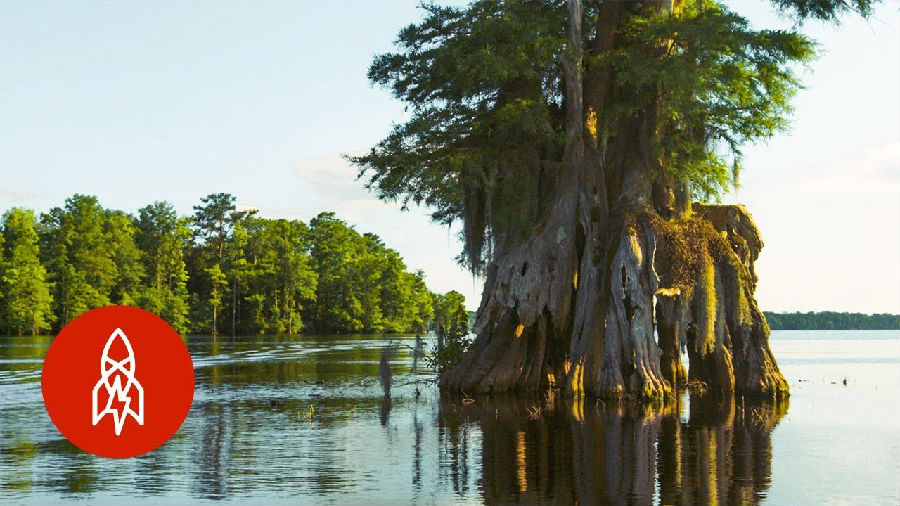The Dismal Swamp is an environment that has hazardous conditions associated with it.
迪斯默爾沼澤是個非常危險的地方。
The heat.
這里氣溫很高。
You got poisonous snakes and mosquitoes come out at certain times of the year and it's unbearable.
有些季節還會有毒蛇和蚊子出沒,這里的環境簡直讓人難以忍受。
But when you think about some of the torture the enslaved peoples endured,
但當你想到奴隸們遭受的那些折磨時,
I think if most of us were living during that day and we had an option to go in the swamp and live freely,
如果我們中間的大多數人都生活在那個年代,并且可以選擇去那片沼澤地自由地生活的話,
I think a lot of us would take that option.
我想,很多人都會做出那樣的選擇。
From the 17th century until the Civil War, escaped slaves, known as maroons, found refuge in the Great Dismal Swamp.
從17世紀到南北戰爭,逃跑的奴隸,人稱“maroons”(逃亡的黑奴),紛紛躲到了大迪斯默爾沼澤。
Located on the border of Virginia and North Carolina, the swamp was wild and inhospitable.
該沼澤地位于弗吉尼亞州和北卡羅來納州交界處,這是一片不宜住人的荒涼之地。
Nevertheless, it was there that runaways created self-sufficient communities almost entirely cut off from the outside world.
然而,就是在那里,逃亡的黑奴們建起了一個個自給自足并且幾乎與外界完全隔絕的社會。
For the past 10 years, archaeologist Dan Sayers from American University has been studying these settlements.
過去10年里,美國大學的考古學家丹·塞耶斯一直在研究這些安居點。
"Part of what I did was develop this sort of research program called the Great Dismal Swamp Landscape Study.
“我的研究內容包括我發起的一項名為‘迪斯默爾沼澤景觀研究’的研究項目。
Most of my focus has been on archeological discovery of sites out in the swamp as well as historical research and then, of course, trying to understand it.
我的研究主要集中在沼澤地的考古發現以及歷史研究方面,其次就是試圖去理解它。
Before we started our research, there was a sense people lived in the swamp for a variety of reasons
開始研究之前,我們有種人們是出于很多原因才選擇住在那片沼澤地的感覺,

but we really wanted to go in the swamp and find remnants of their lives out there.
但我們是真的很想親自進入沼澤地,去看看他們留下的蛛絲馬跡。
And sure enough, we've been able to look at several sites associated with several of these different groups.
當然了,我們也考察了與某些群體相關的幾個遺址。
Probably an 1790 to 1825 or '30 nail that we found in one of the resistance community settlements.
我們在其中一個反抗社區安居點找到了一枚可能屬于1790年至1825年或1830年的釘子。
I'm sure the population went up and down,
我敢肯定,住在那里人口規模有過波動,
but very strong potential for any given moment for thousands of people that went out into the Great Dismal and formed these multi-generational communities.
然而,很有可能一直都有成千上萬的人逃去那里然后創建出多代聚居的社區的。
It was a radical form of resistance in a good way."
這是一種非常極端的反抗方式,但也是一件好事。”
The runaways who escaped slavery risked everything to be free. Even if it meant living in the harsh environment of the swamp.
逃離奴隸制的人們為了自由甘冒任何風險。即便要他們生活在環境惡劣的沼澤地里他們也在所不惜。
One former slave who briefly lived in the swamp was a man named Moses Grandy.
摩西·格蘭迪是一位曾在沼澤地短暫居住的前奴隸。
"I've done family genealogy research in which I've uncovered a slave narrative by Moses Grandy, who I believe is my great great grandfather's uncle.
我做過家族譜系研究,期間還發現了摩西·格蘭迪講述奴隸生活的史料,他應該是我的曾曾祖父的叔叔。
This is Edmond Grandy, my great great grandfather's headstone, who was born in 1827.
這是我曾曾祖父埃德蒙·格蘭迪的墓碑,他出生于1827年。
He was a waterman and a boatsman on the Dismal Swamp Canal, which was being hand dug.
他是當時正純手工開鑿的迪斯默爾沼澤運河上的一名水手和船員。
And he describes very vividly in the slave narrative how they were treated, what they endured, how they were tortured.
他在作品中非常生動地講述了他們是如何被對待的,他們忍受著怎樣的遭遇以及受到了怎樣的折磨。
If you had that kind of experience and you had an opportunity to come out to the swamp and live freely under, you know, challenging conditions,
如果你也有那樣的經歷,并且有機會逃出來到環境殘酷的那片沼澤地里自由地生活,
you're gonna have a hard time getting them out of there.
你就很難把他們從那里再弄出來。
The idea of Africans setting up communities and being in charge of their destiny in the swamp,
他們的理念就是非洲人在沼澤地建立社區并掌握自己的命運,
I don't want people to ever forget this history.
我希望人們永遠也不要遺忘這段歷史。


